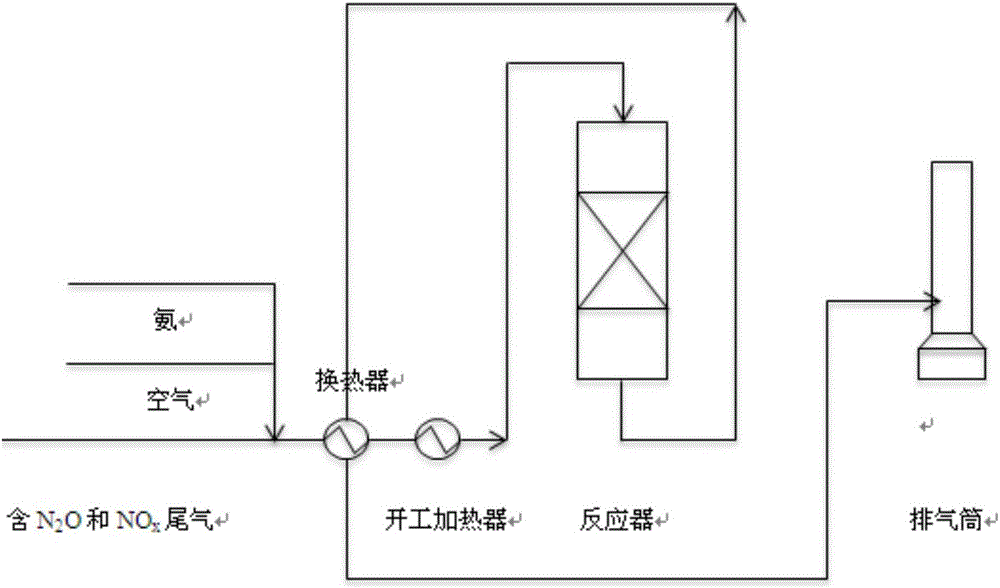Catalyst for integrated removal of N2O and NOx and preparation method thereof
A catalyst and removal technology, applied in the field of N2O and NOx removal, can solve the problems of large investment in equipment and materials, complex process, etc., and achieve the effect of ensuring stability, good load, and inhibiting catalytic denitrification activity
- Summary
- Abstract
- Description
- Claims
- Application Information
AI Technical Summary
Problems solved by technology
Method used
Image
Examples
Embodiment 1
[0038] Catalysts are produced by the following preparation process
[0039] (1) Impregnation: Add 10 grams of ammonium metavanadate and 5 grams of cobalt oxalate into 60 milliliters of ammonia solution with a volume ratio of 1:10, dissolve completely, and impregnate 100 grams of the solution on the alumina support in equal amounts.
[0040] (2) Drying: The impregnated alumina carrier is dried in the shade and then dried with hot air at 120°C.
[0041] (3) Roasting: The semi-finished product after drying is roasted at 550°C to fully decompose the salt.
[0042] (4) Secondary impregnation: After the semi-finished product after roasting is naturally cooled, dissolve 1.6 grams of palladium chloride into 60 milliliters of hydrochloric acid solution with a volume ratio of 1:10, dissolve completely, and impregnate the solution into the carrier of step (3) in equal amounts superior.
[0043] (5) Noble metal reduction: The carrier impregnated with the noble metal uses potassium boroh...
Embodiment 2
[0049] Catalysts are produced by the following preparation process
[0050] (1) Impregnation: Add 14 grams of copper acetate monohydrate and 8 grams of zinc acetate dihydrate into 60 ml of acetic acid solution with a volume ratio of 1:10, dissolve completely, and impregnate 100 grams of the alumina carrier in equal amounts.
[0051] (2) Drying: The impregnated alumina carrier is dried in the shade and then dried with hot air at 120°C.
[0052] (3) Roasting: The semi-finished product after drying is roasted at 450°C to fully decompose the salt.
[0053] (4) Second impregnation: After the semi-finished product after roasting is cooled naturally, dissolve 5.2 grams of chloroplatinic acid into 60 ml of hydrochloric acid solution with a volume ratio of 1:10, dissolve completely, and impregnate the solution into the carrier of step (3) in equal amounts superior.
[0054] (5) Noble metal reduction: the carrier impregnated with the noble metal uses sodium hypophosphite as a reducing...
Embodiment 3
[0060] Catalysts are produced by the following preparation process
[0061] (1) Impregnation: Add 6 grams of ammonium metavanadate and 3.5 grams of copper acetate to 60 milliliters of ammonia solution with a volume ratio of 1:10, dissolve completely, and impregnate 100 grams of the solution on the alumina support in equal amounts.
[0062] (2) Drying: The impregnated alumina carrier is dried in the shade and then dried with hot air at 120°C.
[0063] (3) Roasting: The semi-finished product after drying is roasted at 550°C to fully decompose the salt.
[0064] (4) Secondary impregnation: After the semi-finished product after the roasting is naturally cooled, 13.7 grams of rhodium nitrate are dissolved in 60 milliliters of water, and the dissolution is complete, and the solution is equally impregnated on the carrier of step (3).
[0065] (5) Noble metal reduction: the carrier impregnated with the noble metal uses ascorbic acid as a reducing agent to undergo a liquid phase reduc...
PUM
 Login to View More
Login to View More Abstract
Description
Claims
Application Information
 Login to View More
Login to View More - R&D Engineer
- R&D Manager
- IP Professional
- Industry Leading Data Capabilities
- Powerful AI technology
- Patent DNA Extraction
Browse by: Latest US Patents, China's latest patents, Technical Efficacy Thesaurus, Application Domain, Technology Topic, Popular Technical Reports.
© 2024 PatSnap. All rights reserved.Legal|Privacy policy|Modern Slavery Act Transparency Statement|Sitemap|About US| Contact US: help@patsnap.com










